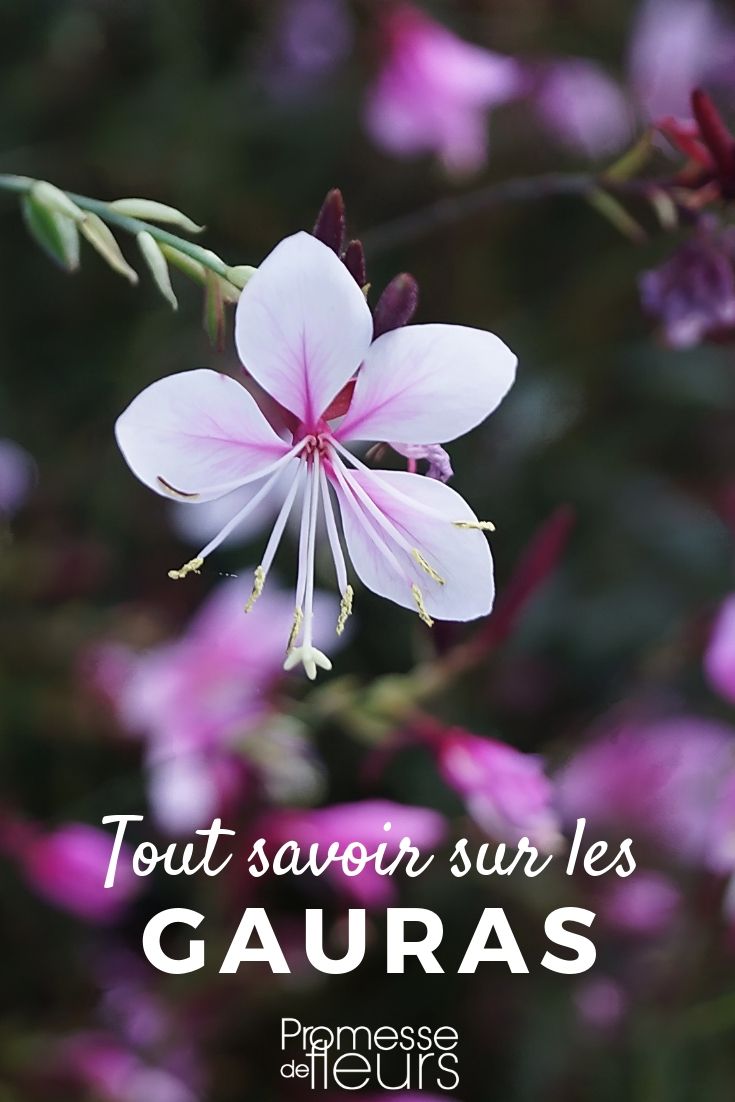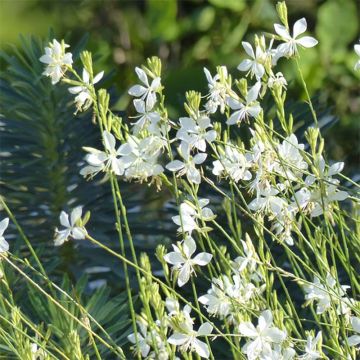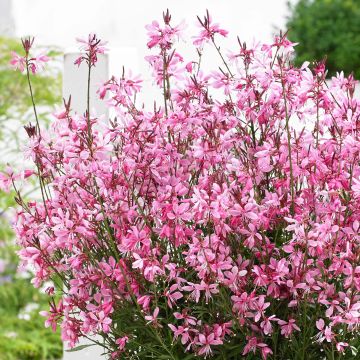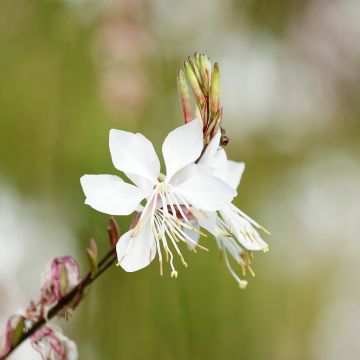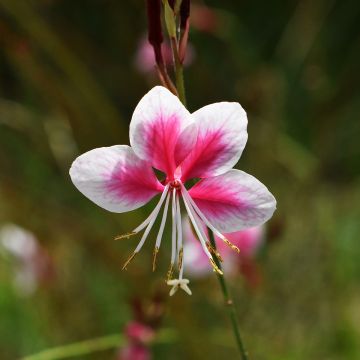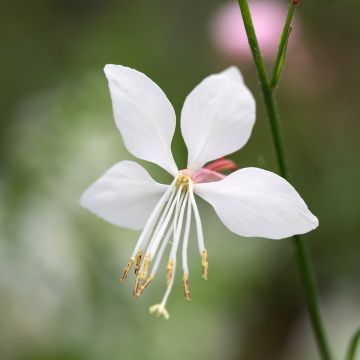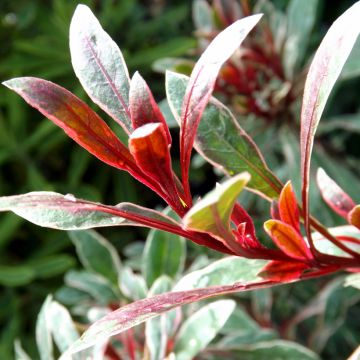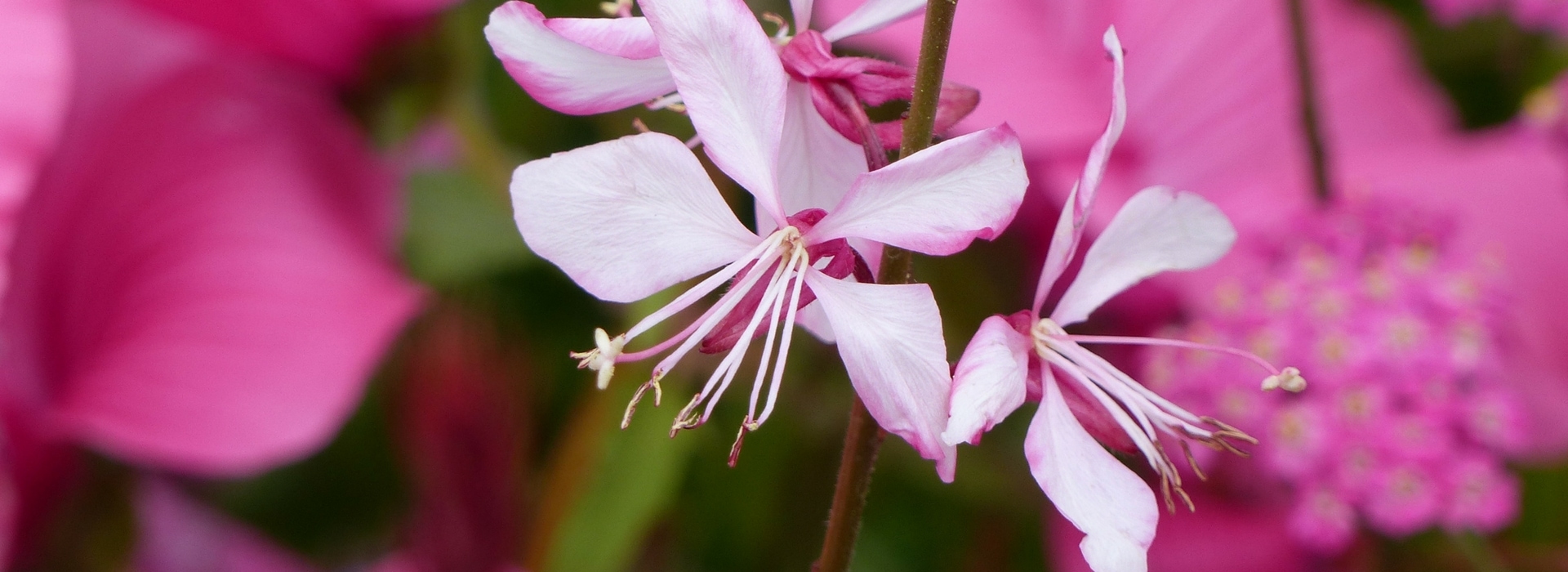
Gaura: planting and growing
Contents
Gaura, in a nutshell
- With its abundant pink or white flowering, lasting for a very long time, Gaura lindheimeri brightens up borders for 6 months, from spring to autumn.
- It is an essential perennial for adding volume and a touch of lightness to borders!
- Requires very little maintenance and is easy to grow, making it suitable for beginner gardeners.
- It tolerates all types of soil, as long as it is well-drained, and also grows well in containers.
- Very trendy, Gaura will charm you with the pure white of the variety ‘Whirling butterflies’ or the vibrant pink of ‘Siskiyou pink’!
A word from our Expert
Do you want a beautiful garden flowering throughout the season without spending too much time on watering and maintenance? Gaura lindheimeri is the plant for you! Its butterfly-shaped flowers that undulate in the wind will add a bright and light touch to your garden, from late spring until the frosts.
Neither demanding nor susceptible to diseases, Gaura is one of the easiest plants to grow. It guarantees you a very abundant and lasting flowering, while bringing elegance and lightness to your flower beds. It has quickly become essential in urban areas, where municipalities regularly plant star varieties like ‘Rosy Jane’ or ‘Siskiyou Pink’ in green spaces and along roadways.
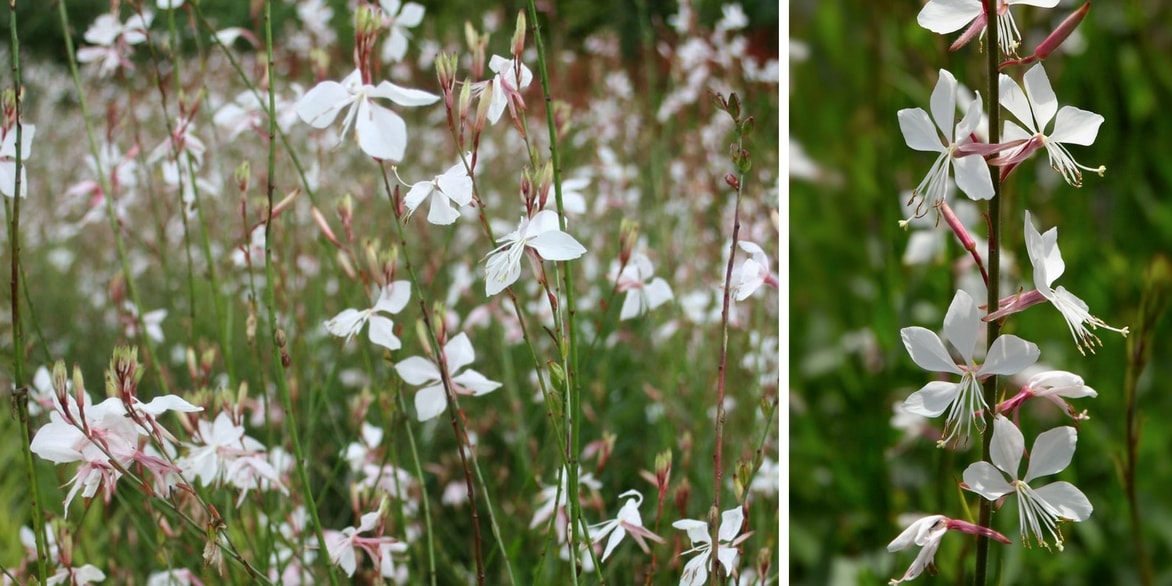 Gaura lindheimeri, varieties with white flowers
Gaura lindheimeri, varieties with white flowers
Gaura is very versatile and can be grown in the ground or in pots, in a mixed border within a very colourful flower bed, or in association with grasses… We are sure it will find its place in your garden! Follow our tips for growing, planting, and propagating it.
Botany
Botanical data
- Latin name Gaura lindheimeri
- Family Onagraceae
- Common name Lindheimer's Gaura
- Flowering white, pink or red. Flowers with 4 petals, arranged in panicles. Flowering period
- Height Between 60 cm and 130 cm for the largest varieties
- Exposure full sun, tolerates partial shade
- Soil type poor and well-drained
- Hardiness -15°C to -20°C
In the wild, Gaura thrives in the arid prairies of the southern United States, primarily in Louisiana and Texas. It can even be found as far north as Mexico.
Introduced to Europe in 1850, it has become a very popular perennial in just a few years, widely used in urban settings to add a bright and natural touch to flower beds and curbs.
There are about twenty species of Gauras. The most well-known and commercially available, Gaura lindheimeri, is often grown as an annual. In nature, Gauras can be annual, biennial, or even undershrubs!
The name “Gaura” comes from the Greek word “gauros,” meaning superb. This is quickly understood when one sees the elegance of its flowers! “Lindheimeri” pays tribute to the 19th-century botanist and naturalist, Ferdinand Jacob Lindheimer.
Gaura is a cousin of the Evening Primrose, Fuchsia, and Epilobium, belonging to the same family: the Onagraceae. This family – which includes over 600 species! – comprises plants with hermaphrodite flowers (possessing both male and female organs), with 4 petals and sepals.
Gaura has a very rapid growth. You can achieve a fairly bushy plant in just a few weeks after planting. At maturity, it reaches between 60 cm and 1.30 m in height depending on the varieties, and 60 cm to 1 m in spread.
This plant forms a bushy clump, from which numerous long and slender stems emerge. These stems bear panicles of star-shaped flowers.

Flowers of different varieties of Gaura: ‘Snowstorm’ – ‘Corrie’s Gold’ – ‘Siskyou Pink’
Gaura offers a generous flowering from May to September, in successive waves. It can thus remain in bloom for 5, or even 6 months! The flowers are often white-pink, but can take on many shades of pink depending on the varieties, even approaching red! They have 4 petals and 8 long white stamens, arranged in panicles about thirty cm long. They are ephemeral, opening at dawn and wilting by evening.
Unfortunately, the flowers are not fragrant. However, they are highly melliferous, attracting many pollinating insects to the garden!

Gaura: flower and leaf
Gaura has small simple leaves, lanceolate in shape with a dentate margin. They are alternate and fuzzy on both sides. The basal leaves are sometimes punctuated with red spots. Some varieties even have purple foliage (variety ‘Crimson butterflies’) or variegated foliage (‘Corrie’s Gold’). Gaura is deciduous, so there is no need to worry if you see the leaves drying and falling in autumn! You will have to wait until spring for new ones to appear.
If you notice red spots on the leaves, there is no need for concern! This is not a disease or pest, just a normal character of the plant. It is indeed common for the basal leaves to be punctuated with red spots.
Thanks to its taproot, Gaura can draw water from deep down and thus withstand drought. This root makes repotting and transplanting delicate operations. Therefore, it is best to plant it and leave it in place for several years.
It is a relatively hardy plant, which is not very frost-sensitive, although there are variations depending on the species. Thus, the white varieties can withstand down to -20°C, compared to -15°C for the pink ones. If the soil is properly drained, there is virtually no risk of them dying from the cold.
Used as a cut flower, Gaura inevitably adds a delicate touch to a bouquet! Its flowers can last a week in a vase.
Varieties
There are around twenty botanical species, and at least as many varieties selected for their aesthetic appeal.
Our favourite varieties:

Gaura lindheimeri Siskiyou pink
- Flowering time August to November
- Height at maturity 60 cm
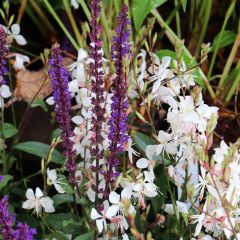
Gaura lindheimeri Whirling Butterflies
- Flowering time August to October
- Height at maturity 1 m

Gaura lindheimeri Cherry Brandy
- Flowering time July to November
- Height at maturity 40 cm
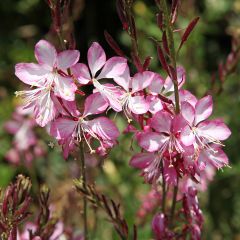
Gaura lindheimeri Rosy Jane
- Flowering time July to November
- Height at maturity 80 cm
Other varieties to discover:

Gaura lindheimeri Corries Gold
- Flowering time July to November
- Height at maturity 80 cm
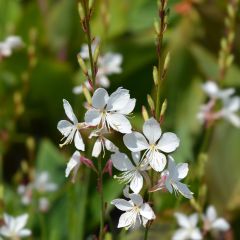
Gaura lindheimeri Snowstorm
- Flowering time August to November
- Height at maturity 60 cm
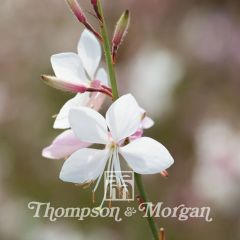
Gaura lindheimeri Sparkle White - Lindheimer's Beeblossom seeds
- Flowering time July to November
- Height at maturity 40 cm
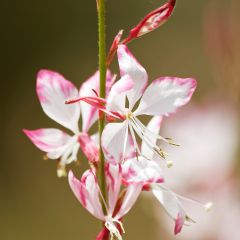
Gaura lindheimeri Freefolk Rosy
- Flowering time July to November
- Height at maturity 75 cm
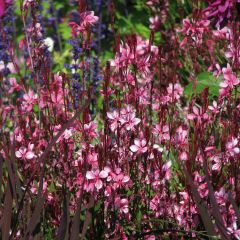
Gaura lindheimeri Lollipop Pink
- Flowering time June to November
- Height at maturity 40 cm
The botanical species:
These are wild plants, much less common in cultivation than horticultural varieties.
- Gaura biennis
Gaura biennis is a biennial plant that grows in meadows, rockeries, and deserts of North America. It is mainly found in the United States and as far north as southern Quebec. It offers a beautiful flowering from July to September, in a bright white or pink tone, with flowers arranged in dense spikes. Its leaves measure between 5 and 10 cm long.
- Gaura coccinea
This is a perennial also originating from the United States, where it can be found in various environments, even in cities. Its ephemeral flowers are initially white, turning pink and then red as they bloom. They are arranged in dense spikes. Its leaves are slender and measure between 2 and 3 cm long.
Discover other Gaura - Bee Blossom
View all →Available in 3 sizes
Available in 4 sizes
Available in 2 sizes
Available in 0 sizes
Available in 3 sizes
Available in 3 sizes
Available in 2 sizes
Available in 3 sizes
Available in 1 sizes
Available in 1 sizes
Planting, maintenance and care
Planting
Gauras are best planted in full sun, in well-draining soil. They can tolerate slightly shaded conditions, but it is essential to avoid north-facing exposures! Plant them in spring, as soon as the last frosts have passed.
If your soil is heavy and clayey, you will need to drain it to prevent excess moisture. Simply add sand, gravel, or small pieces of broken pot. You can also plant Gaura on a mound of soil to prevent water from pooling around the collar.
Don’t worry if you see “visibly dead” Gaura plants in the nursery in March: these are the dry branches, remnants of last year’s growth. Gaura will regrow from the base by the end of March.
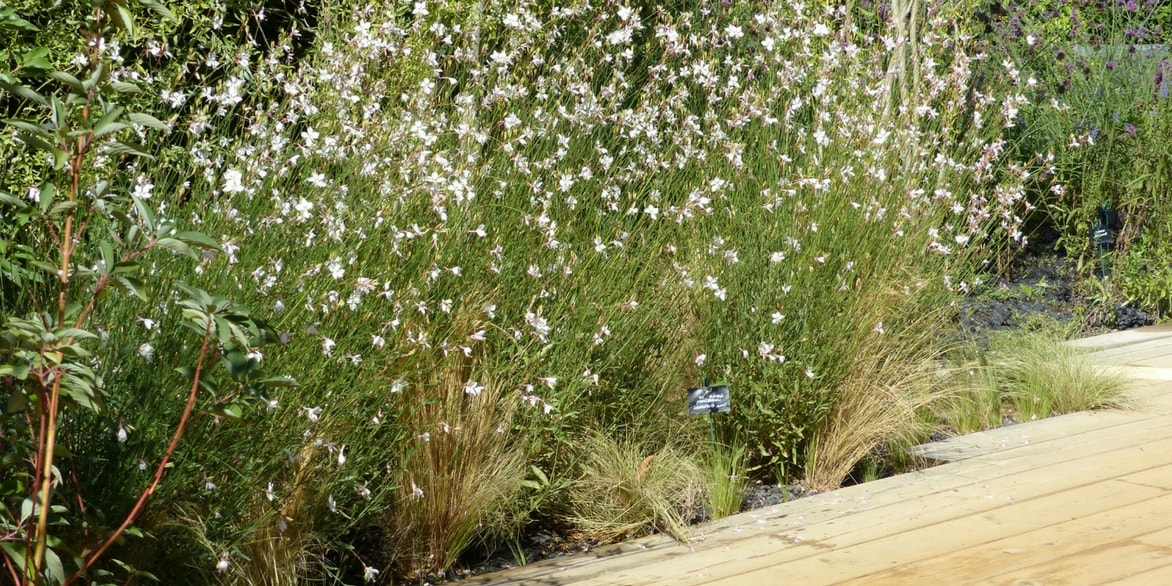
Gaura and grasses in a mass planting
Feel free to plant Gaura in pots or window boxes! It will look stunning when accompanied by some perennials or annuals. Just ensure you have a container that is wide and deep enough, and place gravel at the bottom to prevent water from stagnating.
Maintenance, Pruning and Care
Gaura can sometimes tend to flop due to the length and fineness of its stems. To maintain a well-branched habit, you can prune the stems that are growing a bit too outward. This will help it keep a good shape and encourage the emergence of new flowers. Another tip is to mound or bury the collar of the plant.
If you live in an area where severe frosts below -10°C are common, it is imperative to plant in well-drained soil: the combination of cold + excess moisture can cause the roots to rot.
Although its taproot allows it to access water deep in the soil, we recommend watering during prolonged dry spells or extreme heat.
Easy to grow, Gaura does not have specific diseases or pests. The main issue it may encounter is root rot due to stagnant moisture.
One of the few drawbacks of Gauras is that they only live for a few years. They need to be replaced every 3 to 4 years. However, this still allows plenty of time to enjoy their abundant flowering!
It is essential to prune Gaura at the end of winter. In March, cut back the stump to about 10 cm above the ground to maintain a harmonious shape and remove dead stems. These should not be cut earlier, as they protect the base during the cold season! New shoots will appear soon.
After each flowering (which occurs 2 to 3 times during the summer), cut all the stems that have flowered. This will stimulate the appearance of new flowers.
To learn everything about planting Gauras, check out our detailed advice in our guide: “Gaura: when, where and how to plant”, and for more tips on When and how to prune Gauras?, consult our tutorial guide!
Multiplication: Sowing, Division and Propagation by Cuttings
To propagate Gaura, we recommend propagation by cuttings: it is quite easy to achieve and produces plants identical to the mother plant. Clump division is much more delicate. Sowing takes longer, and if you collect seeds from horticultural varieties yourself, the young plants may not be identical to the original plant.
Sowing
Gaura easily self-seeds in the garden, provided that a few faded flowers are left on the plant. However, it is pointless to hope to reseed the pink-flowered varieties: these horticultural cultivars are sterile…
You can also collect these seeds to sow manually. The seeds, shaped like orange wedges and about 3mm in size, are easily recognisable. However, be careful: for horticultural varieties, prefer propagation by cuttings or division of the stump, as these are the only methods capable of producing new plants identical to the mother plant! If you wish to sow these varieties, it is better to buy the seeds.
- Sowing in open ground, in spring:
Start by working the soil on the surface, breaking up clumps, and spread a little potting soil. Then sow the seeds and cover them with a thin layer of potting soil. Next, lightly press down with the back of a rake. Water. The soil should remain moist until the seeds have germinated.
Discover our tips for sowing seeds in open ground.
- Sowing in buckets under cover:
Carry out the sowing 1 to 2 months before the planned planting date in the garden.
Fill the buckets with a special sowing potting mix, then water them. Place the seeds and cover them with a thin layer of potting soil. Keep them under cover at a temperature between 20 and 24°C, and continue to water them regularly. Again, ensure that the substrate remains moist until the seeds have germinated. You can then reduce watering.
From April onwards, you can plant the young plants in the garden.
Gaura flowers as early as the year of sowing, but the flowering will be much more beautiful and abundant the following year!
Clump Division
When they form a sufficiently large clump, it is possible to multiply Gauras by dividing the clump at the beginning of spring. However, the taproot makes this operation very delicate. That is why we do not recommend it… To multiply your Gauras, prefer propagation by cuttings!
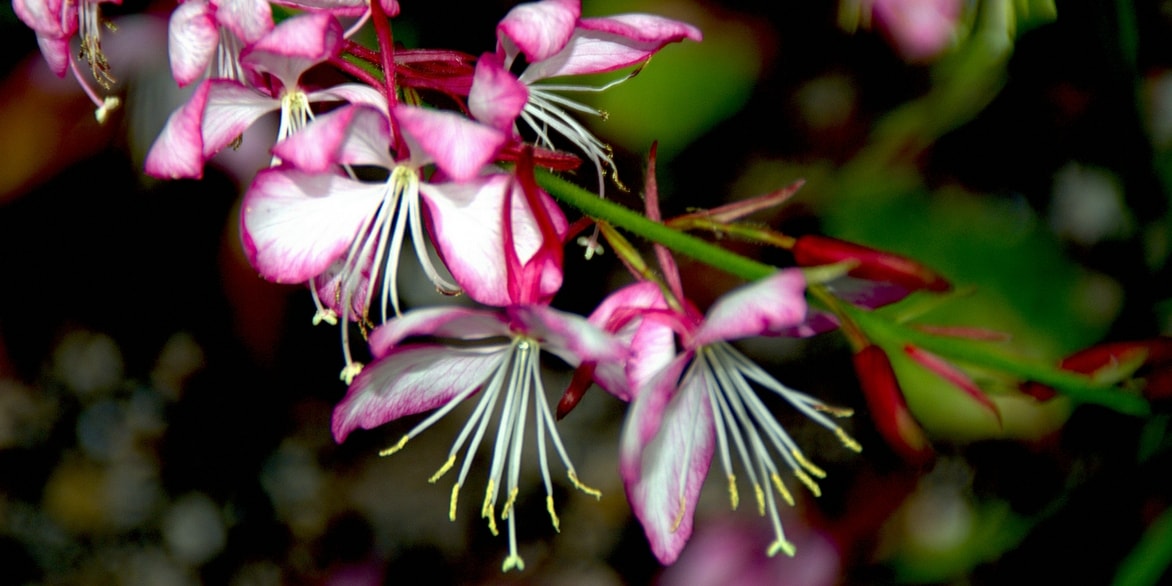
Gaura lindheimeri ‘Rosy Jane’
Propagation by Cuttings
Gaura is quite easy to propagate by cuttings. This operation can be carried out from March, before flowering.
Start by preparing buckets by filling them with a mixture of potting soil and sand, then water the substrate. Take a non-flowering stem, about 10 cm long, cutting it cleanly just below a node (leaf insertion point). Optionally, remove a few leaves. You can dip it in a little rooting hormone. Make a hole in a cell using a pencil. Place the cutting and then press around it to keep it upright in the substrate. Water.
Place the cuttings at a temperature of 20°C and continue to water them regularly.
Association
Very versatile, Gaura pairs well with the graphic design and delicacy of grasses for a very modern effect, as well as in combination with other plants featuring colourful flowers in an English mixed-border. Placed alongside freely and airy flowering plants, it creates a flowering meadow effect. With its airy flowering, it brings lightness next to shorter or more compact plants.

Various combinations with Gaura: Gaura ‘Rosy Shimmer’ and Persicaria affubus ‘Darjeeling Red’ – White Gaura and Echinacea Pallida – Gaura ‘Rosy Jane’ and Pennisetum ‘Hameln’
Its white or pink flowers are perfect for accompanying other plants in cool or pastel tones (blue, mauve, pink, or white). For a very romantic garden, pair it with pink and white flowers: roses, peonies, gypsophila…
Discover many other possibilities in our association sheet: “Gaura, 8 successful pairing ideas”
Useful resources
- On the site, discover our wide collection of Gauras
- Discover our tips for growing a Gaura in a pot, How to propagate Gaura?
- Discover our guide and tips for choosing a Gaura
- Our tips for sowing seeds directly in the ground and mulching your flower beds
- Discover 7 sun perennials with long flowering
- Subscribe!
- Contents
